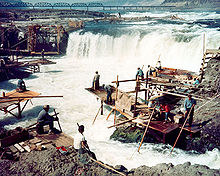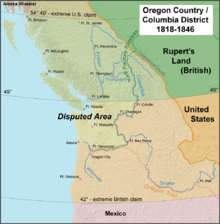History of Oregon
[4] The floods' periodic inundation of the lower Columbia River Plateau deposited rich lake sediments, establishing the fertility that supports extensive agriculture in the modern era.
[7] The earthquake caused a tsunami that was destructive in Japan;[8] it may also be linked to the Bonneville Slide, in which a large part of Washington's Table Mountain collapsed into the Columbia River Gorge, damming the river and forming the Bridge of the Gods, a land bridge remembered in the oral history of local Native Americans.
[9] Celilo Falls, a series of rapids on the Columbia River just upstream of present-day The Dalles, Oregon, was a fishing site for natives for several millennia.
In 1980, Mount St. Helens in nearby Washington erupted violently, temporarily reducing the Columbia River's depth to as little as 13 feet, and disrupting Portland's economy.
[10] Although there is considerable evidence that Paleo-Indians lived in the Pacific Northwest 15,000 years ago, the first record of human activity within the boundaries of present-day Oregon came from archaeologist Luther Cressman's 1938 discovery of sage bark sandals near Fort Rock Cave that places human habitation in Oregon as early as 13,200 years ago.
By the 16th century, Oregon was home to many Native American groups, including the Bannock, Chasta, Chinook, Kalapuya, Klamath, Molalla, Nez Perce, Takelma, and Umpqua.
[13][14][15][16] The Natives generally welcomed the arrival of Europeans in the 19th century, for the increased trading opportunities; however, the introduction of foreign diseases would prove devastating to local populations.
[17] Later, American initiatives to capture the natural resources of the west, especially along the Columbia River, would collide with the interests of natives; many tribes accepted multimillion-dollar settlements from the U.S. government in exchange for giving up traditional fishing sites, moving to reservations.
Official explorers came, at first, primarily by sea, in many cases seeking the Northwest Passage, and later over land, but missed many areas of the state now known as Oregon.
Fur traders and trappers, initially from the Hudson's Bay Company, explored the land more thoroughly, documenting encounters with most of the local Indian tribes.
Nehalem Indian tales recount strangers and the discovery of items like chunks of beeswax and a lidded silver vase, likely connected, to the 1707 wreck of the San Francisco Xavier.
Beginning in the late 1780s many ships from Britain, America, and other countries sailed to the Pacific Northwest to engage in the region's emerging Maritime Fur Trade business.
On October 29, 1830, Smith sent Jackson's Secretary of War John H. Eaton a letter and map containing information that he had gathered from 1824 to 1830 of his explorations into the Rockies, the South Pass, and Pacific Northwest.
[25] The balance of power shifted in the 1830s as thousands of Anglo American settlers arrived, completely dominating the southern half of the disputed region.
Joint occupation ended with the signing of the Oregon Treaty in 1846, when Britain and the U.S. split the disputed region equally, along present borders, with the U.S. generally receiving lands south of the 49th parallel.
[citation needed] A party returning east discovered the South Pass through the Rocky Mountains, which would become an important feature of the Oregon Trail.
During this time the North West Company put the Astorian scheme into practice, sending supplies by sea to the Columbia River and exporting furs directly to China.
Babcock chaired two meetings in 1842 at Champoeg (halfway between Lee's mission and Oregon City) to discuss wolves and other animals of contemporary concern.
The infamous "Lash Law," requiring that blacks in Oregon – be they free or slave – be whipped twice a year "until he or she shall quit the territory," is passed in June 1844.
The Barlow Road, Meek Cutoff, and Applegate Trail represented efforts to cross the Cascades in the northern, central, and southern parts of Oregon, respectively.
Settlement increased because of the Donation Land Claim Act of 1850, in conjunction with the forced relocation of the native population to Indian reservations.
[30] Oregon Senator Col. Edward Dickinson Baker was killed leading Union troops at the Battle of Ball's Bluff on October 21, 1861.
At the time, most Oregonians held white supremacist and racial exclusionary views and were indifferent if not hostile towards abolitionism, but wanted to prevent the land in Oregon from being taken over by large plantations as in the Southern United States so that they would not have to compete with bonded labor.
Her most noted non-fiction, which covered many western states, was written while under contract with Hubert Howe Bancroft's History Company, and at the time was published under his name.
New York City Muckraker Lincoln Steffens was surprised when he visited in 1908 to discover that: Oregon has more fundamental legislation than any other state in the Union excepting only Oklahoma....Yet it has enacted laws which enable its people to govern themselves when they want to.
The power, food, and lumber provided by Oregon helped fuel the development of the West, although the periodic fluctuations in the nation's building industry have hurt the state's economy on multiple occasions.
The state has a long history of polarizing conflicts: Native Americans vs. British fur trappers, British vs. settlers from the U.S., ranchers vs. farmers, wealthy growing cities vs. established but poor rural areas, loggers vs. environmentalists, white supremacists vs. anti-racists, social progressivism vs. small government conservatism, supporters of social spending vs. anti-tax activists, and native Oregonians vs. Californians (or outsiders in general).
Oregonians also have a long history of secessionist ideas, with people in various regions and on all sides of the political spectrum attempting to form other states and even other countries.
A 1994 report from an Oregon Supreme Court task force found minorities more likely to be arrested, charged, convicted, incarcerated and on probation than "similarly situated non-minorities.
In April, Oregon joined Washington and California in the Western States Pact, an agreement to coordinate the restarting of economic activity while controlling the outbreak.





